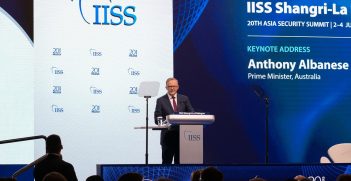China’s J-10C Fighters and Strategic Manoeuvres in Chinese Arms Exports

China promotes advanced indiginous fighter jet for international sale, adding new competition to a market dominated by Western defence firms. Whether the J-10C can reach the gold standard of marketable fighter jets is still in question.
In the vast theatre of international air shows, where nations flex their aerial prowess and show off their military power, China recently made a bold statement by dispatching seven J-10C fighters to the Middle East. These agile, single-engine jets, part of the People’s Liberation Army Air Force’s (PLAAF) August 1st Aerobatics Team, graced the skies above the renowned Dubai Airshow, and more recently Saudi Arabia’s World Defence Show.
The J-10C, also known as the “Vigorous Dragon,” is China’s first domestic advance jet fighter, and is considered fourth-generation plus-plus. The jet now aims to soar to new heights – not only in aerobatic displays, but as a contender in the global arms market. Despite its advanced capabilities, recent upgrades, and impressive aerial display, the lingering question remains: why won’t any air force buy China’s J-10C fighters?
An original Chinese design?
The J-10, born from the state-owned Chengdu Aircraft Corporation (CAC), took its maiden flight in 1998, entering service with the PLAAF in 2005. Its delta wing draws close parallels with the French Mirage Series.
The Chinese jet is also comparable to the United States’ F-16 Fighting Falcon, and is designed to perform for air superiority, strike, and reconnaissance missions. The J-10C features a canard design that gives it high manoeuvrability and fly-by-wire controls, and is equipped with 11 external hardpoints to carry a variety of air-to-air and air-to-ground weapons.
However, beneath the wings of this ostensible “great leap forward” in Chinese military aviation capabilities, and original Chinese design, is an interesting twist. Beijing has historically lacked the technology and know-how to build indigenously-designed advanced engines.
The J-10’s earlier iterations relied on a Russian-built AL-31 engine designed for the Russian Su-27 for use as dual engines. Yet, the J-10 operates the Russian engine as a single unit. While this engine choice marks a strong departure from a wholly domestic creation, the morphing of Russian and Chinese engineering showcased China’s pragmatic approach to technological challenges.
The latest variant in the J-10 series, the J-10C, is fitted with a more powerful Chinese WS-10B Taihang engine, a home-grown product signalling China’s growing capacity for developing advanced engines.
Dubai Airshow 2023: showcasing to the world
In previous years, Chinese delegations to international airshows like Dubai 2023 would have been wearing the buyer’s hat. Times have shifted, and the August 1st Aerobatics Team’s mesmerising performance demonstrates China’s deliberate attempt to position itself as a military hardware supplier, particularly showcasing the Vigorous Dragon to potential Middle Eastern nations.
The Dubai Airshow is reputed as one of the most prominent aviation events globally, providing a platform for a wide variety of commercial, business, and military aircraft – serving as a prime opportunity for China to demonstrate the capabilities of its advanced domestic jet.
China’s entrance into the global arms game
In a world where the United States and European nations have traditionally dominated the arms export market, China emerges as a formidable alternative. Unlike its Western competitors, China positions itself by offering more affordable advanced weapons, without attaching stringent political conditions. This strategic move has garnered increasing interest from the Middle East.
Egypt expressed interest in the J-10C in May 2023 after the August 1st Aerobatics Team made its first overseas appearance at the Langkawi International Maritime and Aerospace Exhibition in Malaysia. The Egyptian air force delegation was reported to have met with representatives from CAC as it seeks to diversify its military suppliers.
Meanwhile, Algeria has previously bought several Chinese corvettes, small green-water naval ships, and various missiles and drones. Saudi Arabia is also rumoured to be in talks with China to purchase unmanned aerial vehicles and air defence systems.
The J-10C’s successful foray into Pakistan’s Air Force in 2020, marking China’s first foreign sale of a fighter, is a testament to the aircraft and China’s appeal. Pakistan ordered 25 J-10Cs in 2020, with an additional order of 11 aircraft made later. CAC has so far delivered 20 fighters to Islamabad.
With deliveries underway, the August 1st Aerobatics Team’s switch from the older J-10A models to the upgraded J-10Cs signals not just a technological shift, but a diplomatic one. The team’s presence at international airshows serves dual purposes – dazzling audiences with aerial displays and attracting potential buyers for China’s military hardware.It symbolises China’s ambitions to carve out a niche for itself in the global arms market, challenging the status quo and presenting itself as a credible alternative.
The J-10Cs are no strangers to the global stage. Prior displays have been witnessed in the Taiwan Strait, where incurrsions across the median line have been frequent. The Vigorous Dragon has been a proven workhorse in China’s air arsenal and has an operational track record.
The Middle East, with its growing appetite for advanced military gear, has becomes the battleground for the Vigorous Dragon’s ascent. The J-10C’s journey exemplifies not only technological prowess but also diplomatic finesse. China’s aerial ballet fighter jets have become a force to be reckoned with in the modern skies.
Samuel Ng holds a Bachelor of Laws and Bachelor of International Business from the Queensland University of Technology. He is currently a graduate at a commercial law firm and has past experience working in consulting and public sector areas. Samuel is also a Westpac Asian Scholar for Taiwan, having studied at the National Chengchi University in Taipei. His research interests include cross-strait relations, East Asian politics, and political developments in Greater China.
This article is published under a Creative Commons Licence and may be republished with attribution.





